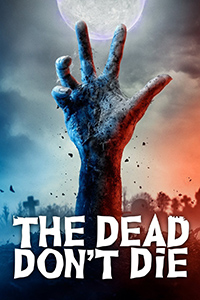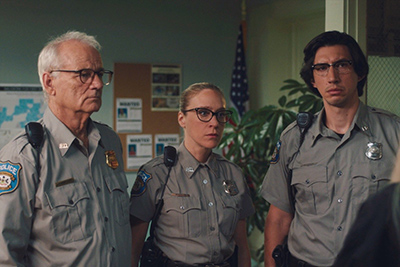George A. Romero’s 1968 film Night of the Living Dead is the gory fountainhead from which springs all of our modern zombie pop culture. There were prior films of note, such as Victor Halperin’s White Zombie (1932) and Jacques Tourneur’s I Walked With A Zombie (1943), but it was Romero who gave us the now canonical tropes. Romero’s zombies shamble slowly, crave human flesh, can only be stopped with a shot to the head, arise for unknown reasons, and repeat patterns from their former lives. (The arch joke of Romero’s 1978 sequel, Dawn of the Dead, is that zombies return to an abandoned shopping mall to roam the stores in a grotesque parody of their consumerism.) Without Romero, there would be no The Walking Dead, Shaun of the Dead, or World War Z. But Romero’s particular imprint—often followed less well by his successors—was to foreground a political agenda, mixing gore with allegory.

It is Romero’s politically charged, schlock horror mode that Jim Jarmusch embraces in his latest film, The Dead Don’t Die, a zombie comedy that takes aim at the Trump era. Its cast is a who’s who of indie film stars—“The Greatest Zombie Cast Ever Disassembled,” according to the movie’s poster—and many in the company are familiar faces from Jarmusch’s films. Our central characters are the three-person police force of Centerville, Pennsylvania, all played by Jarmusch alumni: Chief Cliff Robertson (Bill Murray), Officer Ronnie Peterson (Adam Driver), and Officer Mindy Morrison (Chloë Sevigny).
Centerville is a quaint, one-diner town that becomes terrorized by hordes of the undead. The town’s name, like much of the film, is self-consciously on-the-nose—it might as well have been called Middleamerica, U.S.A.—and the Pennsylvania setting is one of its many nods to Romero, whose life and career were built around Pittsburgh. The loads of self-referentiality combined with Jarmusch’s signature offbeat, deadpan humor have been among the reasons that The Dead Don’t Die has gotten a mixed critical reception, from its tepid opening night at Cannes onward. It’s the scrappiness of the film, though—which at times lumbers, lurches, and even falls apart like a zombie—that’s crucial to Jarmusch’s point. The film is a comedy laced with anger and despair at the state of our world, and its schlockiness contributes greatly to its nervous, desperate humor.
In Jarmusch’s long tenure as a leading figure of American independent cinema, beginning with his landmark first films Permanent Vacation (1980) and Stranger Than Paradise (1984), he carved out a niche as a preeminent chronicler of the mundane lives of quirky outsiders. In films like Mystery Train (1989), Broken Flowers (2005), and Paterson (2016), he celebrated underdogs and the rich, diverse communities that thrive throughout the United States outside the realms of power. The other significant strand in his body of work are his deconstructed genre films where he applies his same sensibility within a template set by Hollywood B-movies, such as his moody Western, Dead Man (1995); his mafia-Kurosawa-gangsta fusion, Ghost Dog: The Way of the Samurai (1999); the neo-noir crime thriller, The Limits of Control (2009); and his lyrical and romantic vampire film, Only Lovers Left Alive (2013). Both his realist and his genre films tenderly embrace the detritus of Americana—the music, movies, TV, and food that make a culture. The anger and despair at the center of The Dead Don’t Die seems to arise from a sense that cultural polarization and conflict are the prevailing attitudes of our time—a direct antithesis of all that Jarmusch’s art stands for.
In The Dead Don’t Die, the ragged semblance of a plot begins with Hermit Bob (played with gusto by Tom Waits), an off-the-grid outsider who becomes our frame narrator. Bob is something of a stand-in for Jarmusch, operating like other lo-fi heroes in the Jarmusch canon such as Isaach De Bankolé’s drifter hitman in The Limits of Control and Tom Hiddleston’s iPhone-resisting vampire in Only Lovers Left Alive. Bob explicitly voices many of the film’s basic themes and messages, including its doom-laden final lines about the world going to hell. A collection of random characters and unfinished plot arcs radiate through the film, which includes a trio of teenagers from the city, a horror-literate convenience store worker (Caleb Landry Jones) in a Nosferatu T-shirt, and a group of children imprisoned in a juvenile detention center. This last group, which deliberately evokes the Trump administration’s child separation tactics along the border, is left painfully stranded in the narrative, where escaping from their prison into a world of zombies seems a meager victory.
The anti-Trump agenda is thick on the ground, nowhere more explicitly than in the character of Farmer Frank (Steve Buscemi), who wears a red baseball cap printed with the slogan “Keep America White Again.” More subtle than the hat is Jarmusch’s framing of conversations in the Centerville town diner between Farmer Bob and his friend Hank Thompson (Danny Glover), a mixed race friendship maintained genially despite the unmentioned white supremacist headwear. The precise cause of the zombie outbreak, in good Romero fashion, is never named, but it is strongly implied that the current administration, U.S. cultural conflict, and environmental devastation have conspired to raise the dead in vengeance. And, as Adam Driver’s character repeatedly reminds us: “This is all going to end badly.”

That bad end, which arrives for many of the “disassembled cast,” allows Jarmusch to decorate the plot with interesting actors in tiny roles. Standouts of this type include Rosie Perez, who appears as a newscaster with her name spoonerized to Posie Juarez. Carol Kane plays a chardonnay-soaked wino-zombie who might prefer booze to flesh. And, in the most substantial and bizarre minor part in the film, Tilda Swinton is Zelda Winston, another name created by garbling the actor’s name. Winston is less of a character than a metastatic genre mash-up: a Scottish, samurai-sword-wielding, Zen-practicing mortician who seems to be part of another movie altogether. Many of these characters are only half-realized, and many critics have understandably focused on the irresolution of some plotlines. The jagged edges in the plot and character construction, however, contribute to the film’s scrappy, thrown-together aesthetic.
The Centerville police’s grappling with the outbreak of zombie-ism is the primary story line through the film, and Driver and Murray’s interplay is one of the film’s highlights, supplying a great deal of Jarmusch’s characteristic off-kilter dialogue as well as meta-commentary that adds to the film’s raggedy edges. The film’s theme song, for instance, is by hip country musician Sturgill Simpson—a credit Driver announces to Murray as the song plays on a CD in their patrol car. Later, the reanimated corpse of Sturgill Simpson ambles past dragging a broken guitar. Driver is also the first to say aloud that he thinks a zombie crisis is underway, and when Murray challenges his repeated claim that all will “end badly,” Driver says he knows this for a fact because he has read the movie’s script. Murray becomes exasperated because, he insists, he has “worked with Jim” longer than Driver has. These demolitions of the fourth wall have a sloppiness that is sometimes more tedious than clever, but the slapdash aesthetic lets The Dead Don’t Die feel more like an authentic B-picture in the mode of Roger Corman/American International Pictures than like slicker-seeming grindhouse homages such as Robert Rodriguez’s Planet Terror. And most of Romero’s zombie films also pop with self-conscious allusions to the genre, such as when Shaun of the Dead creators Edgar Wright and Simon Pegg make a cameo in Romero’s Land of the Dead (2005).
More interesting than Murray and Driver discussing Jarmusch, however, are the many ways in which The Dead Don’t Die alludes to—indeed, cannibalizes—Jarmusch’s earlier works. The first reanimated corpses to claw out of their graves in search of living flesh are a couple played by Sara Driver (no relation to Adam), who has appeared in several Jarmusch films, and Iggy Pop, who was the subject of Jarmusch’s documentary, Gimme Danger (2016). The couple stalk Centerville’s diner, moaning “Coffee!!” which they guzzle in an echo of their former lives and in a zombified version of the vignettes in Jarmusch’s omnibus film Coffee and Cigarettes (2003). Wu-Tang Clan’s RZA, who has worked with Jarmusch since the 1990s, appears as a deliveryman wearing a brown uniform with a gold “WU-PS” logo. And there are deeper cuts, such as Tilda Swinton’s kimono and hairstyle that mirror the woman at the center of Jarmusch’s video for Talking Heads’ “The Lady Don’t Mind.” These references and recyclings are part of the movie’s charm, and they contribute to its central themes of exhaustion, annihilation, and end times.
Romero openly acknowledged that Night of the Living Dead was about the political despair at the end of the 1960s, and The Dead Don’t Die seems like a step further—despair at the end of the American project. The Dead Don’t Die will not likely be seen as a top-tier Jarmusch film, or even a top-tier zombie comedy, which might make it a work for completists only. But it has value as a smaller, crankier companion to the great political horror comedy of this year, Jordan Peele’s Us. In both films, there is a sense that we are in an age of reckoning for a culture that is unsustainable. Ending badly is Jarmusch’s verdict. Everything is coming to a bad end, and there is nothing new under the sun—but in his latest film, it is clear that Jarmusch is still hanging out in the wreckage with a few of his favorite things.
Charles Andrews is Professor of English at Whitworth University.













